Hamauri

Mitzsu-san, a drummer and teacher who is married to my djembe teacher, Daiki-san,
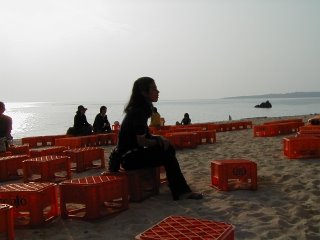
told me about an event she was involved in, to celebrate Women’s Day.
On March 31, I drove north up the coast of Okinawa to Shiokawa Beach, on the outskirts of Nago City. Although the trip was only about 65 km (about 40 miles), it took me almost an hour and a half to get there. Okinawa is a long, narrow island running north and south, with one main road running the length of the island. Route 58 has four lanes through its most congested areas, but it’s also the major commercial artery of the island and runs through the middle of most urban areas. The only alternative is to take the Okinawa Expressway, 50 kilometers of something like an American toll road. It cost me roughly $8 each way to use it, but the expressway is the only good way to cover any great north-south distance on Okinawa. The expressway has two lanes going in each direction. The left-side lane (because in Japan we drive on the left) is the doing-exactly-the-speed-limit lane, while the right-side lane is the light-speed lane. You can’t drive the “gentleman’s speeding” pace we’re used to in the States --- where you’re within maybe 15% of the speed limit and figure you’re not going fast enough to be worth stopping. Nope, in Okinawa it’s either 80 kph (the speed limit) or 120 kph. I tried driving around 90 kph, because it didn’t feel too too-fast, but it wasn’t really possible. Every time I moved into the passing lane to go around some law-abiding citizen, an impossibly tiny car trailing a sonic boom would Doppler into my rear-view mirror and I’d barely have time to move my pokey self back into the slow lane before its rear window was winking at the top of the next hill.
The expressway only got me part of the way there. After the expressway ended, I still had half an hour’s drive through the tangle of Nago’s streets and across to the west coast, then north through a maze of redirected roads, huge construction trucks, and jagged landscapes of raw dirt, onto a narrow blacktop road winding between the hills and the sea. The flyer for the Women’s Day beach celebration is written in Japanese, so I was navigating by some directions scribbled in the margins and the map that comes in the English-language yellow pages. I missed the entrance to the beach, but realized where I was when I saw a woman in a bright sarong walking along the side of the road. After some confusion about parking (no matter where you are in the island, a parking space is the most rare of commodities), I found the place. Finally, I had come to Women’s Day in Nago.
In Okinawa, time is somewhat more flexible than many of us are used to, so although I arrived 20 minutes after the festival was supposed to start, things were only beginning to get set up. I spent some time walking around to get a feeling for what was going to happen. The organizers had spread banners around part of the back

walkway and stairs of a row of shops to make a pretty effective stage, with a sound system and a guy under an awning actually making it work. They’d scattered plastic milk crates in an arc below the stage for audience seating, and to one side of the impromptu amphitheatre a dozen or so artisans had spread blankets. There was some
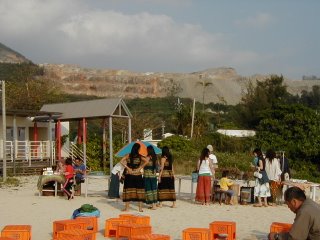
amazing stuff: jewelry, hand-painted shirts, pottery, organic baked goods, lavender water and resonant crystals and found-wood art frames and a homemade Okinawan condiment that can remodel the roof of your mouth. I tried to buy as many things as I thought I might actually use, because several of these people were my friends and because I think you should spend your money locally, with the people who actually make the things.
And, throughout everything, there was constant music. Not all of the vendors were women, not all of the crowd were women, but all of the musicians and performers were
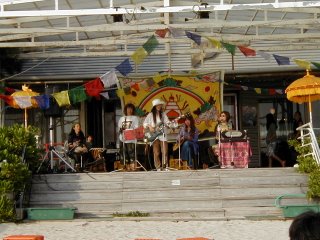
women. Women played the most amazing variety of instruments, and sang, and danced; mothers with their daughters, women with their friends. It was all so unstructured --- people would play, or dance, and feel their way into new music, and drift from one song into another, and stop and talk to the audience. For part of the afternoon, a large and delicate woman accompanied by several beautiful girls who may have been her daughters taught as many of the audience as would try to dance a hula dance. As they taught, they sang the story song, and after a while a young man with a guitar
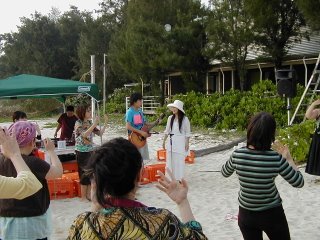
got up and accompanied them. Later, they performed, and it was like nothing I’ve ever imagined. These dances were nothing like the thing we think of as hula (shaped by commercials for resorts and from reruns of Fantasy Island). Watching them, I suddenly realized --- Hawai’i is as close to Samoa or Tahiti as it is to Los Angeles, and their culture owes no debt to Europe. Those women danced something solid and powerful, graceful but not lissome; their feet were flat, their heels pounded the ground, their elbows and knees made precise angles. And instead of Don Ho and ukeleles, they danced to the pounding of a closed cylinder of wood that could have been a tree stump, rhythmically pounded into the ground or slapped by the women

who were singing for the dancers. Hula is tribal. (But of course, it can also be ballet, as my amazingly talented friend Sofuku demonstrated later that evening.)
So I walked around for a while, and waded as far into the ocean as I could without soaking myself for the rest of the day, and bought what I could and then hiked my purchases back to the car, and drank a bottle of cold jasmine tea. For a while, the people I knew were too busy to socialize with (and I’m not very good at that, anyway, except with people I’m very good friends with), and except for me and, later, maybe one other women who looked Western (but I didn’t go ask), everyone there was Japanese. But I’ve had four decades to get used to feeling alone in a crowd, like the "just one thing that’s not like the others," so that feeling doesn’t hurt the way it once did. Now I just live through it, because the alternative is never to do anything new, and I love to see the world like an addiction. That’s worth any amount of feeling like the gorilla at the party. And suddenly I realized, I have a recorder and a camera --- and for the first time in my life, the old familiar feeling of being the person on the outside looking in made PERFECT SENSE. I’d found what I was meant to do: to talk and listen and look, and use my long-angle perspective to recreate it all to tell other people about, later.
I found Okako, who speaks wonderful English, selling crystals and semi-precious stones, and even though I didn’t know her I thought, she has such good English, I can start by talking to her. And she told me about what Women’s Day in Japan means

(a day when, traditionally, women go to the sea to purify themselves). In the process, I discovered that she works at the Star Rose Café in Okinawa City, which I’ve heard a lot about because it’s a combination of local artists’ gallery and visiting performers’ workshop space and, I think, also a place you can get something to eat. So she told me about the henna workshop and I asked her if the African dance teacher was going to do another seminar, and suddenly I had a concrete connection to something that was already part of the peripheral landscape of my life, and I started to feel more comfortable. Then I saw Sofuku, who sometimes takes drum classes and who not only speaks English really well but wears the most creative

jewelry. She’s an amazingly talented woman, an artist and a dancer and an environmental activist. I’ve heard about the “Hug the Earth” project for a while now, but because I can’t read the Japanese fliers I never realized that it’s Sofuku’s work. She photographs people holding a replica of the earth, and asks them to write in her notebook a message for the earth. As she says during our interview,
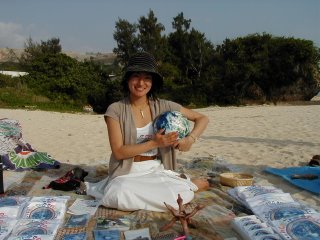
she wanted a way to bring the idea of the earth down to a scale that people could relate to in a personal way. What she’s done is take her photographs and add to each the quote from the person in the photo, and blow them up and frame them in a gallery of eco-consciousness. It’s an amazingly creative idea, and she’s such an energetic, positive presence that her idea is contagious.
I listened to a lot more music, and spent some time being amazed by the
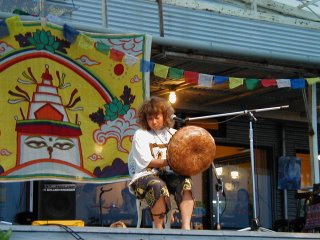
kaleidoscopic interaction of the sky and the sea.

I watched the daylight fade, and found myself standing further and further away from the lights of the stage and the
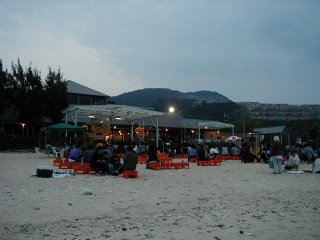
murmur of people. And, yes, I did: I walked into the warm living sea and brought it to my hands, my eyes, my hair, and offered my hope that what came from me in the coming year would be an echo of the calm and powerful sea in which I stood. I even sang, but oddly the audio of that part has been lost.

ALBERT'S WEBSITE IS UP!!! If you'd like to hear my recordings of the music and the people at Women's Day, go to www.WildVoice.com and look for my show, Hamauri, on the New Shows list. If you don't see it there, click on "People" at the top of the page and look for me under "torahc" and from my home page go to "Shows." GO TO WILDVOICE!
